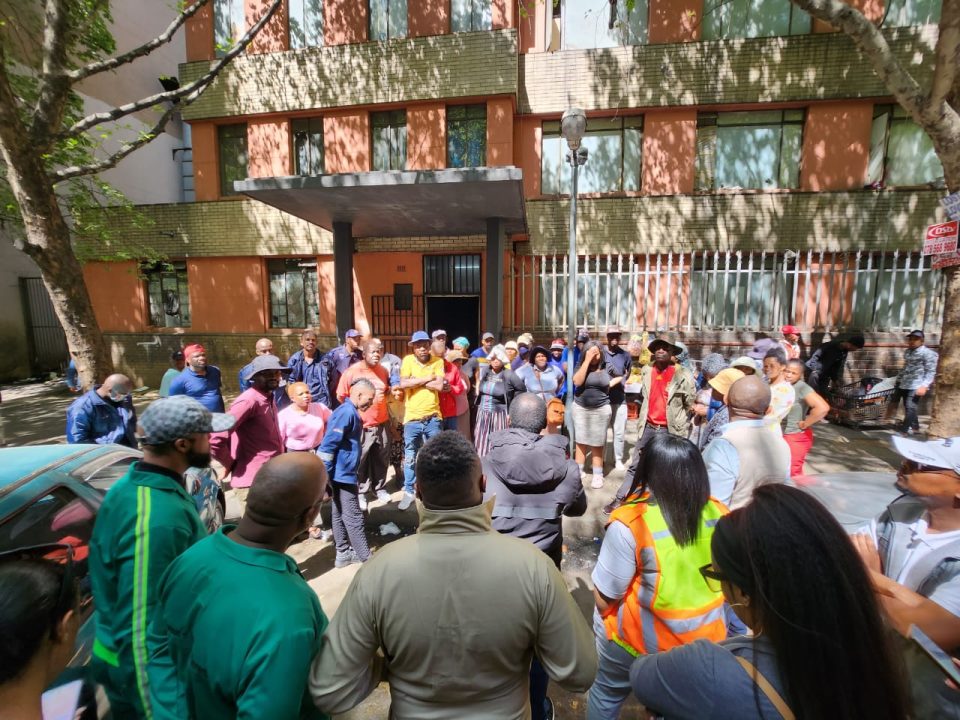
The Member of the Mayoral Committee (MMC) for Human Settlements, Anthea Leitch, today continued her oversight work to witness first-hand the circumstances around and state of some of the many hijacked buildings in the Johannesburg inner city.
Accompanied by the Region F Human Settlements Director, Dumisa Chili, and the relevant local ward councillors, the MMC visited the Wembley Shelter, Old Perm Building, MBV sites, MOTH Building and other structures.
The Wembley Stadium area continues to see a mix of problems, including illegal foreigners who argue that government should cater for their needs since a building they were occupying in 2016 burnt down.
Hundreds of container homes set up for other displaced South Africans have also never been used as temporary accommodation and today they house people calling it their permanent home. At least two taps were seen to be running at full pressure constantly, an enormous waste for our city. Stories of unauthorised individuals running rent rackets to extract undeserved payments from residents are totally unacceptable, along with evidence that another opportunist sold unallocated units to desperate people for R7000.

The MMC and her team witnessed first-hand the effects of poverty and squalor, as people living in a grimy, mud-flecked tent village injected themselves with heaven-only-knows what or smoked away their worries.
At the MBV Phase 1 building, the MMC encountered an active crime scene as the caretaker had been assaulted and the unit he was living in was burnt by his attackers, who apparently wanted to claim his home for themselves. One of the attackers was allegedly standing on the pavement to welcome the MMC with other onlookers, but made himself scarce when police arrived.
The MMC witnessed a building in serious decay, a theme at all the other sites too, with blocked drains and the stench of sewage. This building can still be repaired and restored to a more functional state, however, though it is in the first phase of being hijacked.
The Old Perm Building was more far gone, with the basement now flooded for more than a year, threatening the building’s structural integrity. Residents have resorted to using a bucket toilet system and taking water from a fire hose in an area that was once the bank’s customer area.
Rubbish build-up was also common at all the buildings MMC Leitch inspected today.
The MOTH Building opposite Park Station was the most far gone in terms of hijacking. Inside, the MMC came across a mini world of wooden shacks, each with a number. Such a “settlement” is clearly being run with its own rules and illegal landlords collecting rent. Much like the site of the tragic fire in Marshalltown last week, this building is a tinder box waiting to ignite.
We must pray to God that the unthinkable does not happen before the Department of Human Settlements is able to execute on its plan to reclaim this building and put it back into a habitable state.
Today’s oversight forms part of preparations for an upcoming mayoral committee meeting to give feedback to Executive Mayor Kabelo Gwamanda on the state of housing in the inner city and the mitigation measures the city intends to put in place to avoid a repeat of the 80 Albert Street deathtrap.
MMC Leitch has taken note, however, of the stance of the NGO SERI, who publicly said today that it was the choice of the people they represent to rather stay in a dilapidated building than be left homeless on the street, regardless of the fire risks.
The department of human settlements remains committed to providing access to safe, quality housing to all South African citizens, but the city simply cannot cope with the additional demands of foreigners flocking into our metro to place an overwhelming strain on an already buckling infrastructure system.
The MMC calls on her colleagues in provincial and national government to help the city to put in place a holistic, practical plan to either deport illegal immigrants or rehome those with valid asylum or refugee status in a more sustainable manner than we have seen now for the past decades.
The inner city of Johannesburg remains full of potential for redevelopment and even gentrification, but this will not be possible as long as it continues to be treated as a human dumping ground.
INFO SUPPLIED.


